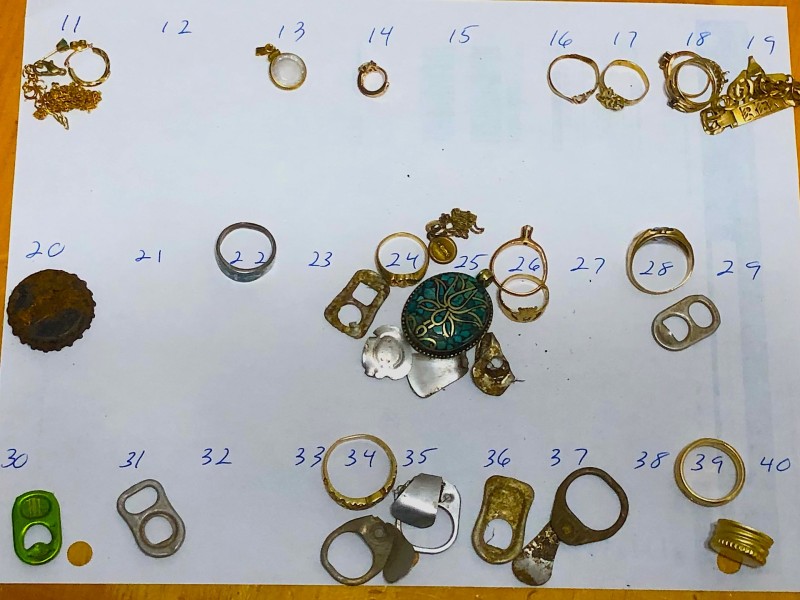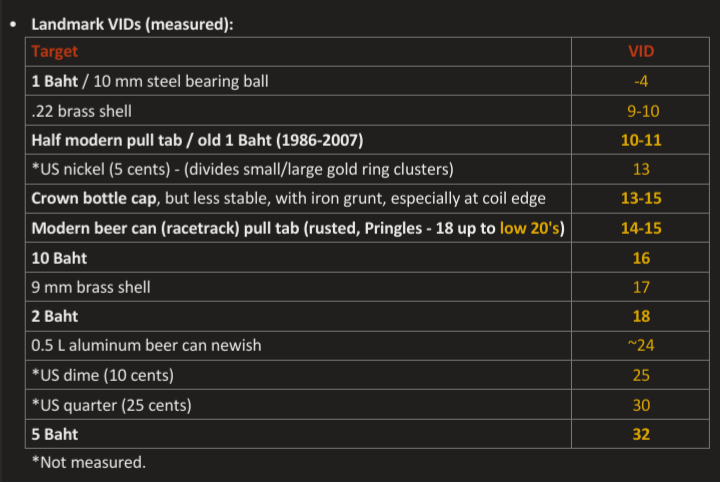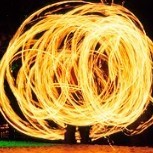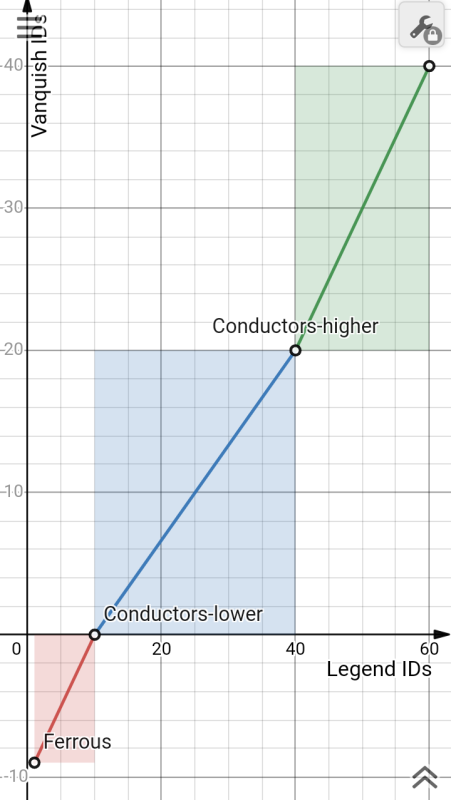-
Posts
177 -
Joined
-
Last visited
Content Type
Forums
Detector Prospector Home
Detector Database
Downloads
Posts posted by mcjtom
-
-
An old question/hypothesis (the previous post), but I still haven't satisfied myself. Vanquish is no longer a popular topic, but I wonder if anybody figured out how switching its GB by switching between modes could be taken an advantage of? I tried but I'm still not sure.
-
My bet is on this one:
https://www.questmetaldetectors.com/questpro
Chase was concerned with the 92% 'effectiveness' (whatever this actually means) of the USMC one above - with PI and GPR optimised to work in concert to detect landmines - would the Quest hobby VLF even have a chance to be useful on the shrapnel-contaminated mine field under fire, I wonder.
-
While (probably) not related to the detector in the first post, it's still about mines... There is a picture on top of this article. The detector being used looks to me like a commercial one. Would anybody recognise what model it might be?
-
I just posted a new topic and it seems that it needs to be approved before being visible to others or if I want to edit it. I haven't seen it before. Is that a new rule? Cheers!
-
Here is a glowing article about a mine detector that reportedly combines 2 technologies. Does anybody know more about it? Who makes it? Does it work as advertised? Would it be of use outside of the mine detection context?
-
-
3 hours ago, TexHunter said:
That's right, their segments are larger with more numbers per segment while the 540 is identical to the 600/800 at 2 numbers per segment...
OK, but disregarding the notch segments width differences and just looking at the ID values on any Vanquish model and 600/800, how well those scales correspond to one another? e.g. would a target that rings say 13 on the Vanquish be expected to also ring 13 on 600/800, everything else being equal etc ?
-
7 hours ago, TexHunter said:
not the 340, or 440 as they have a different segmented scale...
The may have different notching division, but the numerical ID scale is still the same: from -9 to 40.
-
13 hours ago, GB_Amateur said:
other than the obvious 600 scale = 800 scale and 700 scale = 900 scale is quite unlikely. Trying to find a simple correlation between detectors from two different manufacturers -- good luck with that.
Not that it's really important, but would the Vanquish ID scale be much different from Nox 800/600? Simon may know as he's been using both frequently.
-
I'm curious if the new batch of ML detectors has simply doubled the ID scale resolution or has molded it in a different way, stretching things in some places and compressing them in others?
-

ML (-9 to 40) IDs
Legend (1 to 60) IDsOn Jeff's ID charts, several objects seem to be the same. It seems to me, looking at the pull tabs, crown cap, and some rings I can recognize, that several of them that are clustered in 12 to 14 in ML IDs, are spread over the range of some 20 to 31 on the Legend ID scale? My little naive piece-wise linear graph mapping Legend IDs to Vanquish IDs (based on Jeff's testimony 🙂 is probably way off the mark - Nokta may have better separation abilities than it suggests.
-
On 2/16/2023 at 9:56 AM, Jeff McClendon said:
There are an extra 10 target IDs between the beginning of the non-ferrous range (target ID 11) and the beginning of the copper/silver range of target IDs (target ID 40). So 30 target IDs from tiny foil to copper/silver. The Equinox and Vanquish have 20 IDs for the same range of targets. The iron range has 10 IDs like the Equinox and Vanquish. The copper silver range has 20 target IDs that are similar to the Equinox and Vanquish also.
Would this more or less describe it?
-
10 hours ago, Jeff McClendon said:
Here is a photo of some of the gold targets that I have found in the last 2 years placed below their Legend target IDs along with the regularly occurring types of aluminum and steel trash.
Is there an approximate correspondence/mapping between the Legend's ID scale and the (old)Nox/Vanquish one? Would the grouping of objects be similar?
-
-
3 hours ago, GB_Amateur said:
0.01 g and even 0.001 g precision are often needed for determining densities of small items just to get within 10% accuracy.
The little calculator quoted above computes the uncertainty propagation and does the balance of their contributions, which can show you what may work (try 0.1 g for the scale uncertainty and look at pretty wide range of likely densities that it produces for example due to mostly imprecision in estimating volume). But it will not account for gross errors like bubbles etc.
-
3 hours ago, GB_Amateur said:
Pretty sure it's positive.
Yes, thank you.
-
There is 'the Archimedes trick' to try to estimate the density of your nugget a little more tightly - for the size like this you would need a scale with resolution of 0.01 g to narrow the range (less than that probably won't cut it - it will give you large range of possible densities so it will be hard to identify the metal by it).
- Weigh the dry nugget
- Put a cup of water on the scale, zero the scale
- Dip your nugget in water but suspended from a thread or a thin wire
-
Note the scale reading (
it will be negative, butessentially its absolute magnitude is equivalent to mL of displaced water and thus measures the volume of your nugget. - Divide the dry nugget mass (in grams) by the nugget volume (in milliliters or cubic centimeters) to get its density and see how close it is to platinum or other metals and their alloys that you suspect.
Interpretation may be a bit more complicated because there is an uncertainty and range of values involved (hence the need for high-resolution scale to get the volume tightly enough), but I made a little calculator that simplifies things (it may not look like it at first but I promise that it does 🙂
You can change the values in white cells - the rest is calculated.
-
-
I just read that some 1000 Vallon mine detectors are being sent to Ukraine in support of its defence efforts. https://www.vallon.de/en/metal-detectors
Don't know what models. Knowing nothing about mine detecting, I wonder how useful a metal detector may be in finding mines nowadays? I understand that many have very few metal parts and I would imagine that battlefields are awash with shrapnels and all kind of other small metal trash?
-
And some other typical 'landmark' IDs on Vanquish on the beach:

-
The Nox 700/900 seem to have doubled the ID scale resolution. Could anyone offer a guess if this simply means doubling the numerical resolution (as in US nickel moving from 13 to 26 etc.) or also stretching/compressing the scale and thus ID values changing locations (i.e. knowing the IDs on older Nox/Vanquish wouldn't be useful in predicting how items will ring on the extended scale)?
-
-
On a personal note: about a year ago I bought the first 'Mental Detector'. It was great: cheap, looked the part, and beeped a lot. Then I found DetectorProspector.com, read archives, asked questions, listened to deliberately supportive answers and got the Vanquish 440. That was revolutionary.
-
I looked at CTX3030 manual trying to figure out what the 2D detecting screen shows, and I'm still not sure what the vertical scale 'ferrous characteristics' actually show. It seems that its values increase from top to bottom (with the horizontal conductivity scale going traditionally from left to right). So the way I understand it non-ferrous targets should show on top of the screen with the horizonal courser position showing the increasing conductivity (size in a way) from left to right. Is that correct?
Is this convention the same in Manticore? i.e. does the vertical scale have the same meaning, with the increasing ferrous component from top to bottom? Somehow I was under the impression that in the Manticore screen the non-ferrous targets would display along the middle line, with those showing ferrous characteristics departing from it up and down, but I'm not sure if this is true.




.thumb.png.cdeae14524f5eccbf5892812e4dc604a.png)
Advice On Metal Detecting For Gold Nuggets In Finland
in Detector Prospector Forum
Posted
https://youtu.be/d2k4QAItiSA